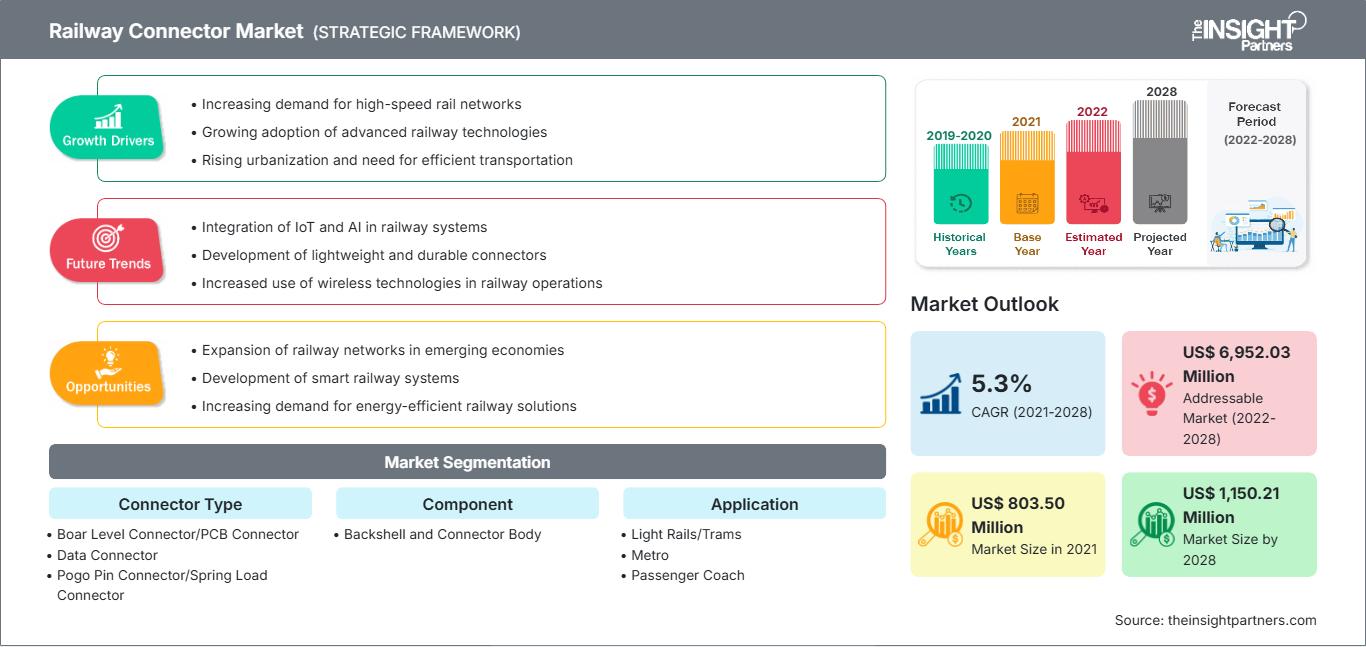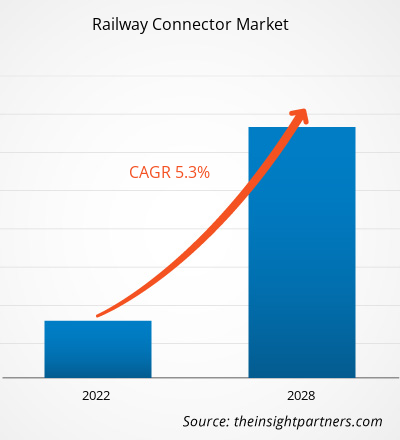Le marché des connecteurs ferroviaires devrait passer de 803,50 millions de dollars US en 2021 à 1 150,21 millions de dollars US en 2028 ; sa croissance est estimée à un TCAC de 5,3 % entre 2021 et 2028.
La croissance démographique, l'évolution des modes de vie et l'urbanisation rapide nécessitent un système de communication ferroviaire interconnecté et stimulent la croissance du marché. De plus, l'augmentation des débits de données et la tendance croissante à la miniaturisation des appareils électroniques favorisent le développement de solutions de communication compactes, robustes et à haut débit. L'émergence des réseaux de transmission numérique sur les chemins de fer pose aux fabricants le défi de développer des concepts de systèmes et des interfaces d'équipements adaptés aux communications de données complexes. De nombreux véhicules européens sont équipés de technologies de pointe, telles que la transmission de données sans fil, ce qui devrait stimuler la demande de connecteurs ferroviaires pour les communications de données complexes en Europe au cours de la période de prévision.
Personnalisez ce rapport en fonction de vos besoins
Vous bénéficierez d’une personnalisation sur n’importe quel rapport - gratuitement - y compris des parties de ce rapport, ou une analyse au niveau du pays, un pack de données Excel, ainsi que de profiter d’offres exceptionnelles et de réductions pour les start-ups et les universités
Marché des connecteurs ferroviaires: Perspectives stratégiques

-
Obtenez les principales tendances clés du marché de ce rapport.Cet échantillon GRATUIT comprendra une analyse de données, allant des tendances du marché aux estimations et prévisions.
Impact de la pandémie de COVID-19 sur le marché des connecteurs ferroviaires
En 2020, la pandémie de COVID-19 a eu un impact négatif à grande échelle sur les économies mondiales. La pandémie a entraîné de nombreux défis sur divers marchés, comme celui des connecteurs ferroviaires. L'offre et la demande ont été fortement réduites en raison d'une faible production. De plus, l'industrie ferroviaire a été impactée négativement par le confinement. Les restrictions sur la chaîne d'approvisionnement ont entraîné un arrêt de la fabrication de connecteurs ferroviaires dans le monde entier. Cependant, les perspectives des projets ferroviaires sont restées dynamiques en 2021. Par conséquent, la demande de connecteurs ferroviaires a augmenté par rapport à 2021.
Analyses du marché – Marché des connecteurs ferroviaires
L'émergence des trains sans conducteur propulsera le marché des connecteurs ferroviaires pendant la période de prévision
L'électrification croissante du secteur mondial des transports, quel que soit le mode de transport, a conduit au développement de méthodes de transport automatisées. Les trains sont les précurseurs de l'automatisation des transports après le transport routier, car la conduite autonome fait son entrée dans le secteur ferroviaire. En Europe, l'exploitation automatique des trains (ATO) devient la dernière tendance qui modernise le secteur ferroviaire de la région. En octobre 2019, six entreprises allemandes, dirigées par Siemens Mobility, ont lancé un projet commun appelé « AStriD ». La croissance des transports urbains et locaux renforce la nécessité d'intégrer des systèmes avancés et automatisés dans le secteur ferroviaire pour optimiser l'exploitation des trains. Par conséquent, la demande croissante de connecteurs pour les trains autonomes offre des avantages aux acteurs du marché des connecteurs ferroviaires.
Informations basées sur les types de connecteurs
Le marché des connecteurs ferroviaires est segmenté en fonction du type de connecteur : connecteurs à large bande/connecteurs PCB, connecteurs de données, connecteurs à broches Pogo/connecteurs à ressort, connecteurs d'alimentation, etc. Le segment des connecteurs à large bande/connecteurs PCB détenait la plus grande part de marché en 2021.
Les acteurs du marché des connecteurs ferroviaires se concentrent principalement sur le développement de produits avancés et performants.
- En janvier 2021, le groupe Fischer Connectors a lancé la construction d'une nouvelle usine de fabrication au Portugal.
- En juin 2021, AB Connectors (TT Electronics) est devenu membre Gold du forum ferroviaire Midlands.
Les tendances régionales et les facteurs influençant le marché des connecteurs ferroviaires tout au long de la période de prévision ont été analysés en détail par les analystes de The Insight Partners. Cette section aborde également les segments et la géographie du marché des connecteurs ferroviaires en Amérique du Nord, en Europe, en Asie-Pacifique, au Moyen-Orient et en Afrique, ainsi qu'en Amérique du Sud et en Amérique centrale.
Portée du rapport sur le marché des connecteurs ferroviaires| Attribut de rapport | Détails |
|---|---|
| Taille du marché en 2021 | US$ 803.50 Million |
| Taille du marché par 2028 | US$ 1,150.21 Million |
| TCAC mondial (2021 - 2028) | 5.3% |
| Données historiques | 2019-2020 |
| Période de prévision | 2022-2028 |
| Segments couverts |
By Type de connecteur
|
| Régions et pays couverts |
Amérique du Nord
|
| Leaders du marché et profils d'entreprises clés |
|
Densité des acteurs du marché des connecteurs ferroviaires : comprendre son impact sur la dynamique des entreprises
Le marché des connecteurs ferroviaires connaît une croissance rapide, portée par une demande croissante des utilisateurs finaux, due à des facteurs tels que l'évolution des préférences des consommateurs, les avancées technologiques et une meilleure connaissance des avantages du produit. Face à cette demande croissante, les entreprises élargissent leur offre, innovent pour répondre aux besoins des consommateurs et capitalisent sur les nouvelles tendances, ce qui alimente la croissance du marché.
- Obtenez le Marché des connecteurs ferroviaires Aperçu des principaux acteurs clés
Le marché des connecteurs ferroviaires est segmenté en fonction du type de connecteur, du composant, de l'application et de la géographie. En fonction du type de connecteur, le marché est segmenté en connecteurs à large bande/connecteurs PCB, connecteurs de données, connecteurs à broches Pogo/connecteurs à ressort, connecteurs d'alimentation, etc. En 2021, le segment des connecteurs à large bande/connecteurs PCB était en tête du marché et représentait la plus grande part de marché. En fonction du composant, le marché est divisé en coques arrière et corps de connecteur. En 2021, le segment corps de connecteur était en tête du marché et représentait une part de marché plus importante. En fonction de l'application, le marché des connecteurs ferroviaires est segmenté en tramways, métros, voitures de voyageurs, etc. En 2021, les autres segments étaient en tête du marché et représentaient la plus grande part de marché. Géographiquement, le marché est largement segmenté en Amérique du Nord, Europe, Asie-Pacifique (APAC), Moyen-Orient et Afrique (MEA) et Amérique du Sud (SAM). En 2021, la région Asie-Pacifique représentait une part importante du marché mondial des connecteurs ferroviaires.
Amphenol Corporation, Kyocera-AVX, Fischer Connectors SA, Harting Technology Group, Molex, LLC (Koch Industries, Inc.), Schaltbau GmbH, Allied Electronics Corporation, Smiths Interconnect, TE Connectivity Corporation et TT Electronics figurent parmi les principaux acteurs présentés dans cette étude de marché. De plus, plusieurs autres acteurs clés du marché ont été étudiés et analysés afin d'obtenir une vision globale du marché des connecteurs ferroviaires et de son écosystème.
- Analyse historique (2 ans), année de base, prévision (7 ans) avec TCAC
- Analyse PEST et SWOT
- Taille du marché Valeur / Volume - Mondial, Régional, Pays
- Industrie et paysage concurrentiel
- Ensemble de données Excel
Rapports récents
Rapports connexes
Témoignages
Raison d'acheter
- Prise de décision éclairée
- Compréhension de la dynamique du marché
- Analyse concurrentielle
- Connaissances clients
- Prévisions de marché
- Atténuation des risques
- Planification stratégique
- Justification des investissements
- Identification des marchés émergents
- Amélioration des stratégies marketing
- Amélioration de l'efficacité opérationnelle
- Alignement sur les tendances réglementaires






















 Obtenez un échantillon gratuit pour - Marché des connecteurs ferroviaires
Obtenez un échantillon gratuit pour - Marché des connecteurs ferroviaires